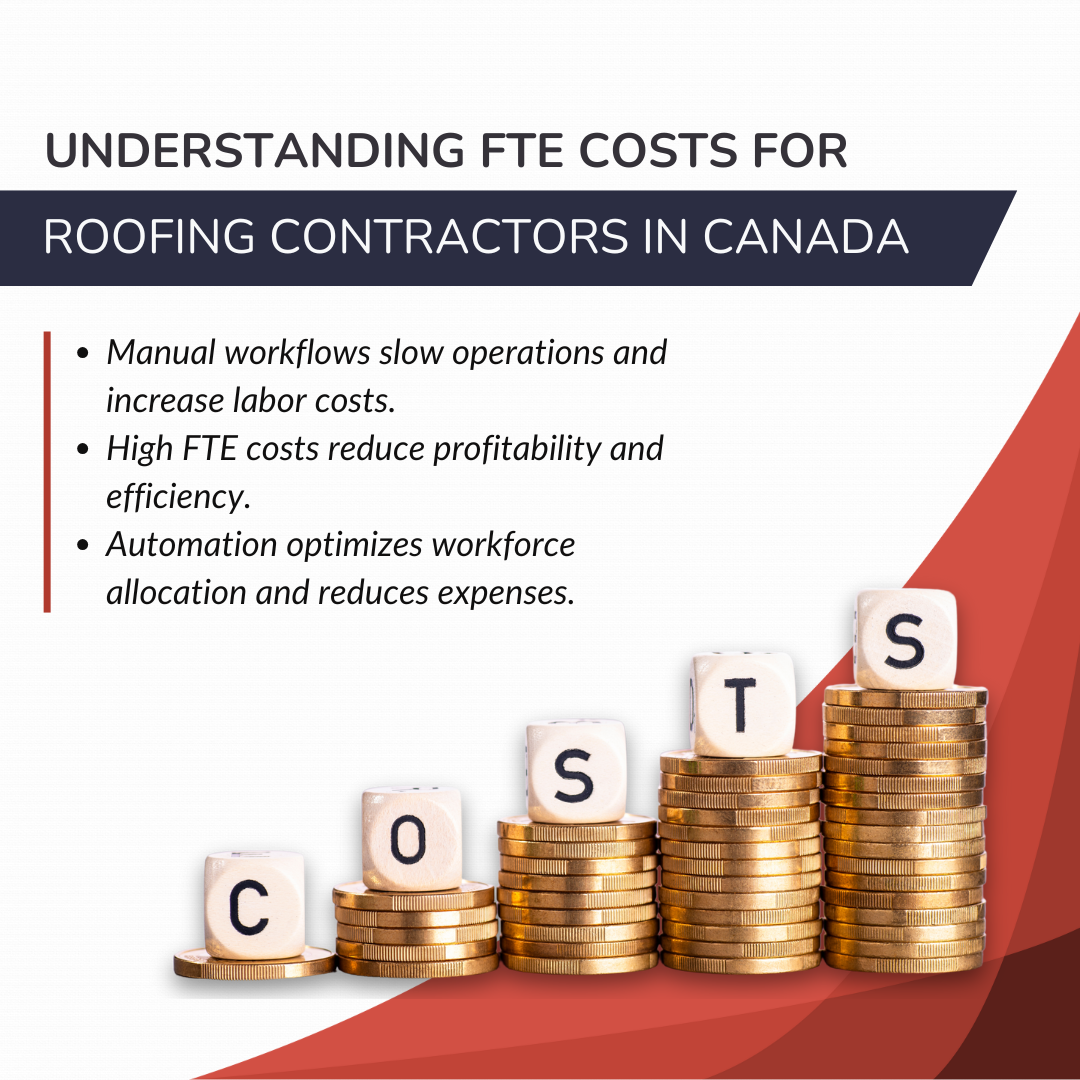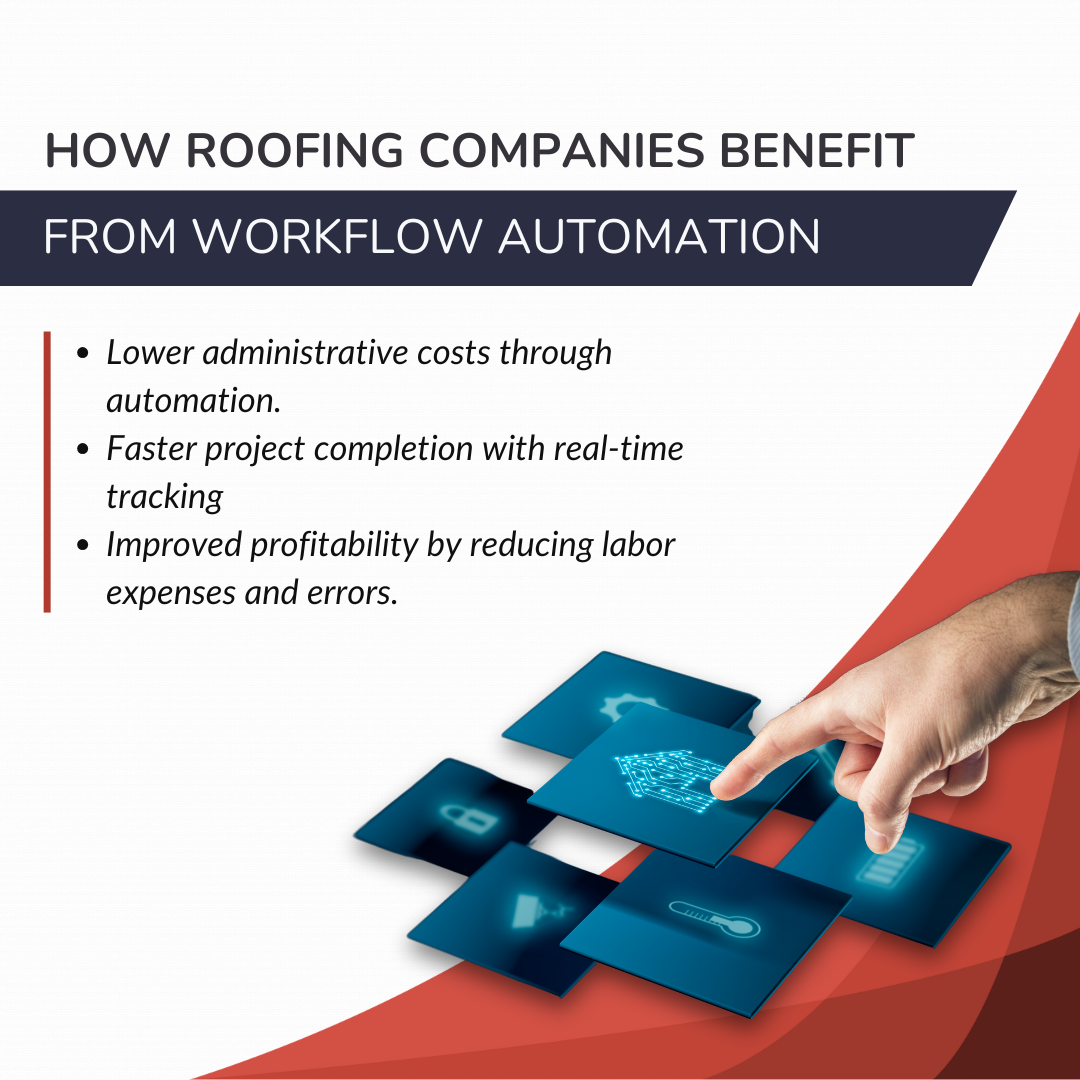April 15, 2025
Many roofing contractors in Canada are still using manual workflows to save money. But what if you’re actually losing it?
Manual workflows in roofing services, including roof repairs, flat roofing, and commercial roofing, slow down operations, raise labor costs, and diminish profitability.
From missed job site updates to endless paperwork, manual systems create more work than they solve.
This blog will show how manual workflows cost roofing companies more FTEs and why automation is the way to go.
Understanding FTE Costs for Roofing Contractors in Canada

Running a roofing business shouldn’t feel like juggling too many balls at once. Sooner or later, something’s going to drop. Yet, that’s exactly what happens when you use old manual workflows.
Let’s break down how these old methods quietly drain your profits and overload your workforce.
> What is FTE (Full-Time Equivalent) in the Roofing Industry?
FTE represents the total labor hours needed to complete roofing projects.
For roofing contractors in Canada, this means understanding how many workers are required to efficiently finish roof repairs, re-roofing, new roof installations, or commercial roofing jobs.
The higher the FTE, the more employees are needed, increasing payroll and operational costs.
> How do Manual Workflows Impact FTE Costs?
- Paper-based scheduling and job tracking increase administrative workload.
- Manual estimation and invoicing lead to billing delays and costly errors.
- No real-time project visibility results in miscommunication and inefficiencies.
- Increased dependency on labor rather than leveraging automation.
The Hidden Costs of Manual Workflows for Roofing Services

If you think manual workflows are just a minor inconvenience, think again. They’re like using a bucket with a hole in it. You keep pouring time, effort, and money, but much of it is wasted.
Let’s take a closer look at how these issues are silently eating into your profits.
How Manual Workflows Increase FTE Costs
Manual processes may seem manageable initially, but they quickly add up in time, effort, and cost. Let’s see how these outdated workflows are draining your resources.
1. Too Much Time Spent on Scheduling and Paperwork
Keeping track of jobs, schedules, and paperwork by hand takes a lot of time.
Roofing contractors often find themselves buried in admin work instead of focusing on actual projects. When tasks aren't properly organized, deadlines get missed, labor is wasted, and costs pile up.
2. Project Delays and Wasted Labor
Old-school tracking methods, such as paper forms and spreadsheets, slow everything down. Work gets delayed if materials don’t arrive on time or the site isn’t ready.
This means paying workers extra hours without getting the job done faster, which can harm the project timeline and the bottom line.
3. Costly Mistakes in Estimates and Job Coordination
Manual calculations for material costs, labor hours, and invoices often lead to expensive mistakes. A small miscalculation can wipe out profits, and incorrect invoices can
cause payment disputes.
Without proper job coordination, teams might do overlapping tasks or stand around waiting for work, wasting time and money.
Also read: Common Roofing Mistakes Contractors Make & How to Avoid Them
Comparing Manual vs. Automated Workflows for Roofing Companies
| Factor | Manual Workflow | Automated Workflow |
|---|---|---|
| Labor Costs | High due to repetitive admin work | Lower by reducing manual processing |
| Project Completion Time | Slower due to lack of real-time updates | Faster with digital tracking |
| Customer Satisfaction | Affected by miscommunication | Improved with automated notifications |
| Scalability | Requires more workforce as projects grow | Scalability without hiring additional employees |
Why Roofing Contractors Need to Automate Roofing Services

Automation is the key to keeping up in the evolving industry. Let’s explore how Canadian roofing contractors can cut costs and streamline operations with smart workflow automation.
> Key Areas Where Automation Cuts FTE Costs
a) Project Management:
Automated job scheduling, tracking, and material ordering ensure no project falls through the cracks. Instead of relying on scattered paperwork or outdated spreadsheets, contractors can oversee real-time job progress from one central dashboard.
b) Estimations & Invoicing:
AI-powered tools eliminate billing errors and delays, ensuring invoices are processed faster and more accurately. Automated cost estimations help contractors win more bids by providing instant, data-backed quotes.
c) Customer Communication:
A smart CRM system automates follow-ups and client interactions, ensuring faster responses and improving customer experience. Automated notifications also help keep clients updated on project progress, eliminating unnecessary phone calls and emails.
d) Job Site Coordination:
Real-time updates enhance team collaboration and efficiency, ensuring smooth coordination for roof replacements and installation services. Contractors can instantly assign tasks, track worker progress, and adjust plans from one digital interface.
> How Roofing Companies Benefit from Workflow Automation

Automation isn't just about cutting costs. It's about working smarter. This is how you can benefit from automation:
a) Lower Administrative Costs
By automating routine admin work, roofing companies can significantly reduce the number of employees needed for scheduling, invoicing, and paperwork. This allows businesses to allocate labor to more productive tasks.
b) Faster Project Completion
Automated scheduling and tracking improve efficiency by ensuring teams stay on track, reducing delays, and speeding up overall project timelines.
c) Cost Savings & Improved Profitability
Automation cuts labor costs, minimizes errors, and streamlines operations, helping roofing businesses become more competitive and profitable.
> The Role of AI in the Roofing Industry
Crucial statistics to consider:
- Less than 30% of roofing companies leverage AI in their marketing strategies, highlighting a broader industry gap in automation adoption. (Roofing Webmasters)
Result? Roofing contractors can reduce labor costs, enhance accuracy, and speed up project timelines by automating tasks, allowing them to maintain a competitive edge.
How to Transition from Manual to Automated Workflows in a Roofing Company
Shifting from manual to automated workflows might seem overwhelming, but it doesn’t have to be. With the right tools and strategy, you can smoothly transition while saving time and money. Here’s how to get started.
Steps to Digitize Roofing Operations
- Identify manual bottlenecks in scheduling, estimation, and invoicing.
- Implement roofing software that integrates with project management.
- Train employees on using automation tools efficiently.
Overcoming Resistance to Automation
- Address concerns about job displacement and software learning curves.
- How small and mid-sized roofing companies can afford automation.
- Demonstrating ROI: How automation leads to better profits & fewer FTE costs.
Also read: The Future of Roofing CRM: Automation, Analytics, and Customer Insights
Introducing Rooferbase: The Smart Solution for Roofing Contractors in Canada

The construction industry in Canada is developing, and roofing businesses can’t afford to lag behind. Manual workflows aren’t just time-consuming. They cost you more labor and lost opportunities
That’s where Rooferbase comes in. It helps roofing contractors simplify operations, cut costs, and improve overall productivity.
1. Automation for Faster Workflows
Rooferbase helps automate estimations and invoicing, eliminating manual calculations and reducing costly errors. With real-time data processing, contractors can generate accurate quotes in minutes instead of hours.
2. Smart Scheduling & Tracking for Better Efficiency
No more manual scheduling nightmares. Rooferbase optimizes job assignments, crew coordination, and material tracking, ensuring that projects stay on schedule while reducing errors.
3. Seamless Customer Management with Integrated CRM
Managing customer relationships has never been easier. Rooferbase’s integrated CRM system enhances customer communication, automates follow-ups, and helps convert more leads into sales, improving overall customer experience.
4. Compliance & Regulation Support
Designed for roofing contractors in Canada, Rooferbase ensures that all workflows adhere to local industry regulations, helping businesses stay compliant without additional administrative burdens. even in varying local climate conditions.
5. Scalable Growth Without Extra Overhead
Whether you’re a small business or a growing enterprise, Rooferbase scales to meet your needs. By reducing the dependency on manual labor, contractors can expand operations without significantly increasing FTE.
Also read: How to Choose the Best Roofing Software for Your Business
Wrapping Up
Roofing contractors in Canada relying on manual workflows unknowingly spend more on FTEs, increasing payroll costs and slowing business growth.
Automating workflows eliminates repetitive tasks, improves project timelines, and improves customer satisfaction. Roofing businesses can increase profits by using tools that make the process cost-effective.
The future of Canada's roofing services is digital. Start automating today!
About Rooferbase
Rooferbase is an all-in-one roofing software for all your roofing needs, from streamlining workflows to reducing labor costs and optimizing roofing solutions.
Book your demo today and experience the difference.
FAQs
1. How does automation reduce FTE costs for roofing contractors in Canada?
By eliminating repetitive tasks, automation allows roofing businesses to operate with fewer employees, reducing payroll costs while improving efficiency.
2. What’s the first step to automating a roofing company?
Start by identifying the most time-consuming manual tasks and investing in roofing software that streamlines scheduling, project management, and invoicing.
3. What role does automation play in improving the quality and speed of sheet metal projects and siding installations?
Automation improves quality by providing precision in cutting, bending, and assembling sheet metal, reducing human errors. It enhances speed by streamlining workflows and optimizes managing shingles by improving material tracking and reducing waste.






